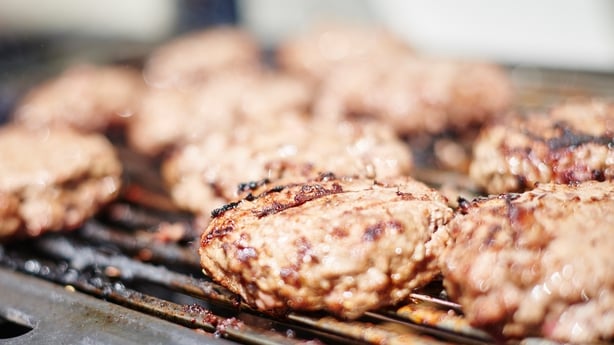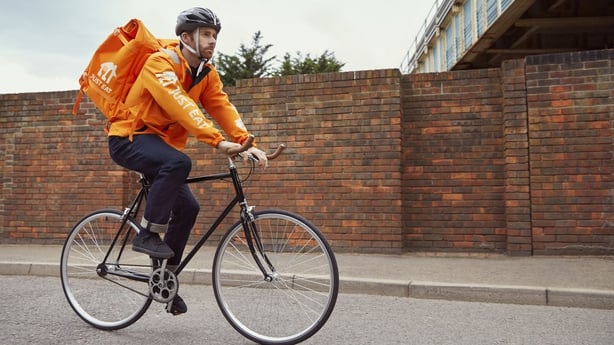The chipper or Chinese has long been a feature of the Irish diet, but the past few years have seen particularly significant growth.
The pandemic is, in part, responsible for that.
When lockdowns closed pubs and restaurants, the local takeaway became the only option when households wanted someone else to cook for them.
And, of course, the pandemic led to a shift in what it meant to be a takeaway - because so many of those shuttered restaurants quickly converted their business into collection and delivery model.
Meanwhile countless cafés and food vans popped up in car parks and on roadsides, offering new options to consumers.
And, in a lot of cases, those options have remained despite the return of in-house dining.
That's in no small part due to the other factor in the growth of takeaways - which is the explosion of delivery app platforms like Just Eat, Deliveroo and Uber Eats.
They’ve made it much easier for restaurants to add and maintain a takeaway option - as they can handle all of the infrastructure, reducing the need for extra staff or resources.
Those apps have also made it easier for consumers too - because they offer a range of options in one place. Users don’t have to set up a new account every time they want to try a new restaurant, and they don’t need to have cash ready for the driver.
And so it’s maybe no surprise that Just Eat’s Food Delivery report for 2023 suggested that the average consumer here spends nearly €47 each a month on takeaways - with an estimated €2.2 billion, before VAT, spent nationally last year.
We need your consent to load this rte-player contentWe use rte-player to manage extra content that can set cookies on your device and collect data about your activity. Please review their details and accept them to load the content.Manage Preferences
But are they getting more expensive?
Definitely.
It’s hard to find concrete evidence on this - or specifics on how much prices have risen by.
The best we can do in terms of official data is the Central Statistics Office’s Consumer Price Index, which includes a category for 'restaurants, cafes, fast food and takeaway food’.
That means takeaways are bundled in with lots of other food businesses, but it gives a good indication of the direction of travel.
Using this category, we can see that prices are 25% higher over the past four years - between April 2020 and April 2024.
So, if that was reflective of takeaways, it would mean a takeaway that would have cost you €25 four years ago, is costing you more than €31 now.
Some consumers may feel that the actual increases they're seeing are above and beyond 25% - but few would argue that it's any lower than that.
Why are prices rising by so much?
Well of course we’ve all endured the significant rise in the cost of consumer goods in the past two or three years - and businesses like takeaways have seen their prices rise too.
That’s reflected in the data the CSO publishes around wholesale prices - which is what a business would pay for goods, rather than what consumers would pay.
Meat and meat products, for example, have seen prices rise nearly 32% in the past four years.
Fish prices are around 29% higher over the same period.
Fruit and vegetable prices - all important when it comes to the likes of your chipper - are 20.5% higher in four years.
The wholesale price of drinks - including soft drinks - is up nearly 23% since April 2020, according to the CSO, while bakery and farinaceous products (which would cover not just the likes of a burger bun, but also pastas and noodles) are around 5.5% higher over the four years.
Even paper prices have gone up by more than 8% in recent years - meaning the packaging your food comes in is costing operators more.
Has there been an issue with potatoes too?

Yes - this was an issue that first raised its head during the height of Brexit tensions, because Irish chippers tend to source their potatoes from the British market.
The fear was that any disruption to trade between the two countries would have an impact on that supply.
But, more recently, the issue has been weather and climate change and its impact on farmers.
A very wet start to the year delayed the planting of potato crops in Ireland - and it was a similar story for British farmers. That's building on disappointing harvests in previous years - meaning that the supply to the market is impacted.
And when you've strong demand and weak supply, prices rise.
But unfortunately the likes of chippers may be particularly impacted by that increase.
Big retail chains tend to have pricing agreements in place with farmers, which they strike well in advance of delivery. As they can buy in bulk they can get a better deal, too.
But smaller operators like chippers and takeaways generally don't have that power - and so they're left to buy stock as they need it, and at market price.
That means they're much more vulnerable to price volatility.
What else is pushing up prices?

Well of course energy is a huge factor for many takeaways and restaurants.
They're running large ovens, massive grills and deep fat fryers for hours and hours each day - and they're energy hungry appliances.
So when the price of energy spiked a little over two years ago, their bills jumped too.
As businesses are more exposed to wholesale price movements, it meant that some small operators may have seen their monthly energy bill rise from €1,000 to €4,000 or €5,000, almost overnight.
Now the wholesale price of energy is falling - as of April of this year it was down nearly 30% year on year, and close to 60% lower compared to 2022.
But that's a fall from a very high base - and when you take a broader look at prices, businesses are still paying a lot more for energy now than was the case in the early stages of the pandemic.
According to the CSO's wholesale price index, electricity prices are still more than three times higher now than they were in April 2020.
Wholesale gas prices are up more than 60% in the same period.
We've heard a lot about labour costs too - are takeaways particularly exposed there?
The Restaurants Association of Ireland itself would say that the food sector in general is very 'sensitive' to things like a minimum wage hike - and you can imagine that's particularly true of takeaways.
There would be a lot of younger people employed there, for example, who are doing this as a job while they’re in college.
Takeaways generally wouldn't have had a pension scheme in place for their workers either, or had sick pay entitlements that went above and beyond the bare minimum.
That means that, when their obligations around those things change, that's going to push up their costs.
And of course the other big thing that's been a big focal point of restaurants and similar businesses in the past year has been the VAT rate - which had been temporarily reduced to 9%, but then restored to the 12.5% rate back in September of last year.
And VAT is a consumer tax - in theory it going up or down should have a direct impact on the price you pay at the till - so that's put upward pressure on prices too.
But there is another, almost hidden charge that many people are paying when they’re getting their takeaway … what you might call an App Tax.
What do you mean?

As already mentioned, food delivery apps have helped grow the takeaway sector, and given a lot of restaurants a platform that they didn't have before.
But that comes at a cost.
Because takeaways and restaurants have to pay to get set up on these platforms - and they then have to pay a commission on any order received through it.
Just Eat, Uber Eats and Deliveroo all confirmed to RTÉ News that there are activation costs and a commission charged; though some were reluctant to go into detail beyond that.
Just Eat would not reveal its commission due to 'commercial sensitivity'.
Uber Eats, though, confirmed that it charges a charge a commission of 13-30% - depending on the circumstances.
According to sources in the food industry, and reports elsewhere, that is broadly in line with what others charge.
The precise commission a restaurant charges can change if they use their own delivery drivers - while it's higher if they rely on the platforms'.
They may also get a better rate if they agreed to list on one platform as part of an exclusivity deal, while bigger brands may also get a better rate than smaller players.
But, one way or another, restaurants are handing over a significant portion of their sales - as much as 30c out of every euro a customer spends. That is a huge amount.
Some may opt to go it alone to avoid that, but not listing on the app means many customers will not see what you have to offer.
Being on these apps is almost as much about marketing your brand as it is about offering a convenient option to customers.
So the takeaway just has to pay the commission?
What generally happens is that consumers pay the commission.
Because most restaurants will charge more for an item on a delivery app than they will if you order it from them directly.
And that difference is them partially or fully passing on the cost of their commission to the consumer.
That may only represent an extra 40 or 50c per item - but across a large order that can add up.
If you're the type to get a takeaway regularly, it could represent hundreds of euro more over the course of a year.
So next time you are ordering a takeaway and baulking at the price, you can soften the blow by ordering directly from the restaurant itself.
That will save you a few euro, but it will also benefit a local business - as they'll get to keep all of the sale, rather than having to share it with a digital middleman.







